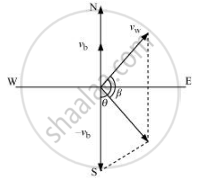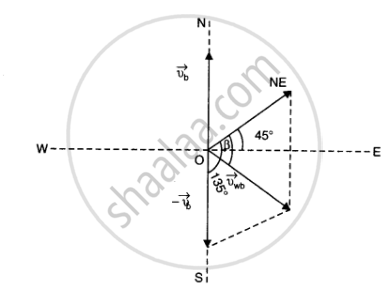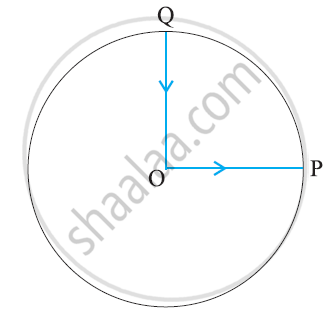Advertisements
Advertisements
Question
In a harbour, wind is blowing at the speed of 72 km/h and the flag on the mast of a boat anchored in the harbour flutters along the N-E direction. If the boat starts moving at a speed of 51 km/h to the north, what is the direction of the flag on the mast of the boat?
Solution 1
Velocity of the boat, vb = 51 km/h
Velocity of the wind, vw = 72 km/h
The flag is fluttering in the north-east direction. It shows that the wind is blowing toward the north-east direction. When the ship begins sailing toward the north, the flag will move along the direction of the relative velocity (vwb) of the wind with respect to the boat

The angle between vw and (–vb) = 90° + 45°
`tanbeta = (51sin(90+45))/(72+51cos (90+45))`
`=(51sin45)/(72+51(-cos45)) = (51xx1/sqrt2)/(72-51xx1/sqrt2)`
`= 51/(72sqrt2-51) = 51/(72xx1.414 - 51) = 51/50.800`
`:.beta = tan^(-1) (1.0038) = 45.11^@`
Angle with respect to the east direction = 45.11° – 45° = 0.11°
Hence, the flag will flutter almost due east.
Solution 2
When the boat is anchored in the harbour, the flag flutters along the N-E direction. It shows that the velocity of wind is along the north-east direction. When the boat starts moving, the flag will flutter along the direction of relative velocity of wind w.r.t. boat. Let Vwb be the relative velocity of wind w.r.t. boat and P be the angle between Vwb and vw (see fig. below)

Now `vecv_(wb) = vecv_w + (-vecv_b)`
Here `|vecv_w| = 72 km/h`
`|-vecv_b| = 51 km/h`
Angle between `vecv_w` and `-vecV_b` is 135^@. Then
`tan beta = (51 sin135^@)/(72+51cos135^@) = (51 sin 45^@)/(72+51(-cos 45^@))`
= `(51xx(1/sqrt2))/(72-51(1/sqrt2)) = 1.0039`
`:.beta = tan^(-1) (1.0039) = 45.1^@`
Angle w.r.t east direction = `45.1^@ - 45^@ = 0.1^@`
It means the flag will flutter almost due east.
Solution 3
When the boat is anchored in the harbour, the flag flutters along the N-E direction. It shows that the velocity of wind is along the north-east direction. When the boat starts moving, the flag will flutter along the direction of relative velocity of wind w.r.t. boat. Let Vwb be the relative velocity of wind w.r.t. boat and P be the angle between Vwb and vw (see fig. below)

Now `vecv_(wb) = vecv_w + (-vecv_b)`
Here `|vecv_w| = 72 km/h`
`|-vecv_b| = 51 km/h`
Angle between `vecv_w` and `-vecV_b` is 135^@. Then
`tan beta = (51 sin135^@)/(72+51cos135^@) = (51 sin 45^@)/(72+51(-cos 45^@))`
= `(51xx(1/sqrt2))/(72-51(1/sqrt2)) = 1.0039`
`:.beta = tan^(-1) (1.0039) = 45.1^@`
Angle w.r.t east direction = `45.1^@ - 45^@ = 0.1^@`
It means the flag will flutter almost due east.
APPEARS IN
RELATED QUESTIONS
A cyclist starts from the centre O of a circular park of radius 1 km, reaches the edge P of the park, then cycles along the circumference, and returns to the centre along QO as shown in figure. If the round trip takes 10 min, what is the (a) net displacement, (b) average velocity, and (c) average speed of the cyclist?

On an open ground, a motorist follows a track that turns to his left by an angle of 60° after every 500 m. Starting from a given turn, specify the displacement of the motorist at the third, sixth and eighth turn. Compare the magnitude of the displacement with the total path length covered by the motorist in each case.
For any arbitrary motion in space, state whether the following statement is true:
`"a"_"average"=["v"("t"_2) - "v"("t"_1)]/("t"_2 - "t"_1)`
(The ‘average’ stands for average of the quantity over the time interval t1 to t2)
For any arbitrary motion in space, state whether the following statement is true:
`"V"_"average"` = `(1/2)("v"("t"_1) + "v"("t"_2))`
(The ‘average’ stands for average of the quantity over the time interval t1 to t2)
In a two dimensional motion, instantaneous speed v0 is a positive constant. Then, which of the following are necessarily true?
In a two dimensional motion, instantaneous speed v0 is a positive constant. Then which of the following are necessarily true?
In a two dimensional motion, instantaneous speed v0 is a positive constant. Then which of the following are necessarily true?
Two balls A and B are placed at the top of 180 m tall tower. Ball A is released from the top at t = 0 s. Ball B is thrown vertically down with an initial velocity 'u' at t = 2 s. After a certain time, both balls meet 100 m above the ground. Find the value of 'u' in ms-1. [use g = 10 ms -2]:
A particle of mass 10-2 kg is moving along the positive x-axis under the influence of a force F(x) = `-"K"/(2x)^2` where K = 10-2 Nm2. At time t = 0 it is at x = 1.0 m and its velocity is v = 0. The velocity of particle will be ______ m/s, when it reaches x = 0.50 m.
The displacement s of a particle depends on time t according to the following relation `s = 1/3t^3 - t^2 + t`. The velocity and displacement of the particle at the instant when its acceleration is zero, are respectively ______.
